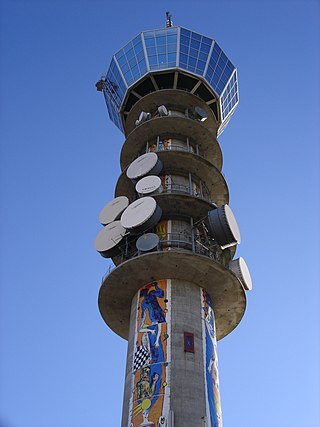Transport in North Korea is constrained by economic problems and government restrictions. Public transport predominates, and most of it is electrified.

Shortwave radio is radio transmission using radio frequencies in the shortwave bands (SW). There is no official definition of the band range, but it always includes all of the high frequency band (HF), which extends from 3 to 30 MHz ; above the medium frequency band (MF), to the bottom of the VHF band.

Radio broadcasting is the broadcasting of audio (sound), sometimes with related metadata, by radio waves to radio receivers belonging to a public audience. In terrestrial radio broadcasting the radio waves are broadcast by a land-based radio station, while in satellite radio the radio waves are broadcast by a satellite in Earth orbit. To receive the content the listener must have a broadcast radio receiver (radio). Stations are often affiliated with a radio network that provides content in a common radio format, either in broadcast syndication or simulcast, or both. Radio stations broadcast with several different types of modulation: AM radio stations transmit in AM, FM radio stations transmit in FM, which are older analog audio standards, while newer digital radio stations transmit in several digital audio standards: DAB, HD radio, DRM. Television broadcasting is a separate service that also uses radio frequencies to broadcast television (video) signals.

The FM broadcast band is a range of radio frequencies used for FM broadcasting by radio stations. The range of frequencies used differs between different parts of the world. In Europe and Africa and in Australia and New Zealand, it spans from 87.5 to 108 megahertz (MHz) - also known as VHF Band II - while in the Americas it ranges from 88 to 108 MHz. The FM broadcast band in Japan uses 76 to 95 MHz, and in Brazil, 76 to 108 MHz. The International Radio and Television Organisation (OIRT) band in Eastern Europe is from 65.9 to 74.0 MHz, although these countries now primarily use the 87.5 to 108 MHz band, as in the case of Russia. Some other countries have already discontinued the OIRT band and have changed to the 87.5 to 108 MHz band.

In radio communication, skywave or skip refers to the propagation of radio waves reflected or refracted back toward Earth from the ionosphere, an electrically charged layer of the upper atmosphere. Since it is not limited by the curvature of the Earth, skywave propagation can be used to communicate beyond the horizon, at intercontinental distances. It is mostly used in the shortwave frequency bands.

The American Forces Network (AFN) is a government television and radio broadcast service the U.S. military provides to those stationed or assigned overseas, and is headquartered at Fort George G. Meade, Maryland. AFN is comprised of two subordinate overseas commands and one directorate in the continental United States. Overseas, AFN Europe is headquartered at Sembach Kaserne, Germany and consists of 15 subordinate stations in the countries of Bahrain, Belgium, Cuba, Germany, Greece, Italy, Spain, and Turkey. AFN Pacific is headquartered at Yokota Air Base, Japan and consists of nine stations in the countries of Diego Garcia, Japan, and South Korea. Stations under AFN Europe and AFN Pacific conduct live local radio shows 12 hours a day Monday through Friday, with the exception of U.S. federal holidays. Stateside, AFN's broadcast operations, which include global radio and television satellite feeds, emanate from the AFN Broadcast Center/Defense Media Center in Riverside, California.
HCJB, "The Voice of the Andes", was the first radio station with daily programming in Ecuador and the first Christian missionary radio station in the world. The station was founded in 1931 by Clarence W. Jones, Reuben Larson, and D. Stuart Clark. HCJB now focuses on Ecuador with unified programming on FM at 89.3 MHz in Pichincha, at 92.5 MHz in Manabí, at 96.1 MHz in Tungurahua and Cotopaxi, at 98.3 MHz in Esmeraldas and with separate programming on AM at 690 kHz. Broadcasts in Spanish and indigenous languages on 6.05 MHz (1 kW), continue on an intermittent basis with a new solid state transmitter which in 2017 replaced an older (5 kW) transmitter. These broadcasts were not listed on the HCJB English website as of February 2016.

CBN is a public AM radio station in St. John's, Newfoundland and Labrador, Canada. It carries a news, talk and information format and is the local Radio One station of the Canadian Broadcasting Corporation.

Voice of Korea is the international broadcasting service of North Korea. It broadcasts primarily information in Chinese, Spanish, German, English, French, Russian, Japanese and Arabic. Until 2002 it was known as Radio Pyongyang. The interval signal is identical to that of Korean Central Television.
WRNO is a commercial shortwave radio station which began international broadcasting on February 18, 1982 and continued regular broadcasting through the early 1990s from Metairie, Louisiana, with a continuation of periodic broadcasts starting in 2009. These call letters are still in use by the New Orleans station WRNO-FM; both were founded and originally owned by Joseph Costello III.
Apex radio stations was the name commonly given to a short-lived group of United States broadcasting stations, which were used to evaluate transmitting on frequencies that were much higher than the ones used by standard amplitude modulation (AM) and shortwave stations. Their name came from the tall height of their transmitter antennas, which were needed because coverage was primarily limited to local line-of-sight distances. These stations were assigned to what at the time were described as "ultra-high shortwave" frequencies, between roughly 25 and 44 MHz. They employed amplitude modulation (AM) transmissions, although in most cases using a wider bandwidth than standard broadcast band AM stations, in order to provide high fidelity sound with less static and distortion.

The Presidential Broadcast Service - Bureau of Broadcast Services (PBS-BBS), is a state radio network owned by the Philippine government under the Presidential Communications Office (PCO).
Radio jamming on the Korean Peninsula makes the border region one of the world's busiest places for radio signals. Medium wave jamming is dominant in the area including Seoul and the Korean Demilitarized Zone (DMZ). South Korea jams all radio and television broadcasts from North Korea, and until 2013 jammed all foreign broadcasts, which was ended during the Park Geun-hye administration.

Radio Rossii is the primary public radio station in Russia.
Fu is a traditional administrative division of Chinese origin used in the East Asian cultural sphere, translated variously as commandery, prefecture, urban prefecture, or city. They were first instituted as a regular form of administrative division of China's Tang Empire, but were later adopted in Vietnam, Japan and Korea. At present, only two fu still remain: the prefectures of Kyoto and Osaka in Japan.

XEUN-AM is a radio station in Mexico City. Broadcasting on 860 AM, XEUN-AM is owned by the National Autonomous University of Mexico (UNAM) as a sister to XEUN-FM 96.1 and XHUNAM-TDT 20.

Cycling has become a common mode of transport in North Korea since its economic transition in the early 1990s.










